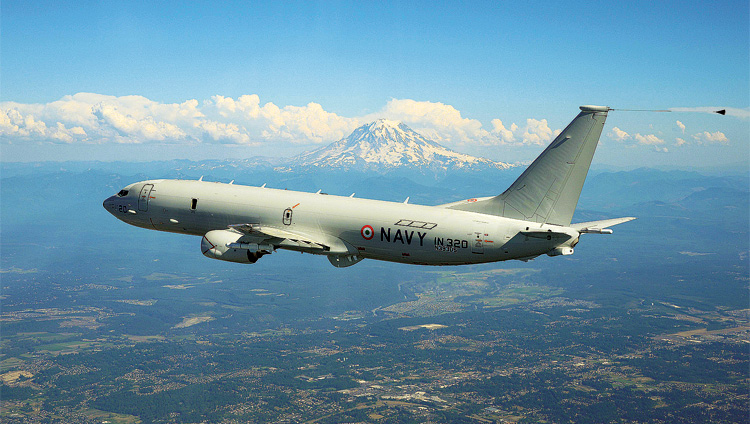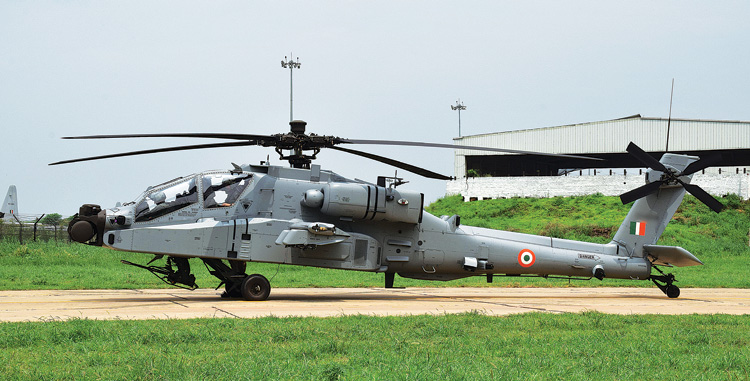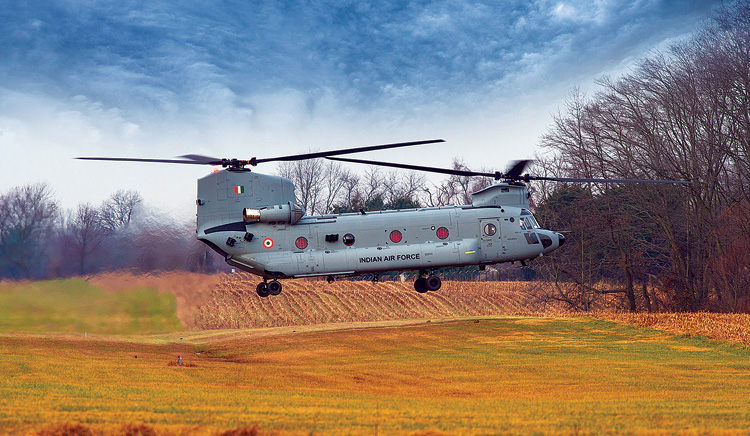INDIAN ARMED FORCES CHIEFS ON OUR RELENTLESS AND FOCUSED PUBLISHING EFFORTS

The insightful articles, inspiring narrations and analytical perspectives presented by the Editorial Team, establish an alluring connect with the reader. My compliments and best wishes to SP Guide Publications.

"Over the past 60 years, the growth of SP Guide Publications has mirrored the rising stature of Indian Navy. Its well-researched and informative magazines on Defence and Aerospace sector have served to shape an educated opinion of our military personnel, policy makers and the public alike. I wish SP's Publication team continued success, fair winds and following seas in all future endeavour!"

Since, its inception in 1964, SP Guide Publications has consistently demonstrated commitment to high-quality journalism in the aerospace and defence sectors, earning a well-deserved reputation as Asia's largest media house in this domain. I wish SP Guide Publications continued success in its pursuit of excellence.
- The layered Air Defence systems that worked superbly, the key element of Operation Sindoor
- Operation Sindoor | Day 2 DGMOs Briefing
- Operation Sindoor: Resolute yet Restrained
- India's Operation Sindoor Sends a Clear Message to Terror and the World – ‘ZERO TOLERANCE’
- Japan and India set forth a defence cooperation consultancy framework, talks on tank and jet engines
Supporting the Modernisation of the Indian Armed Forces
Boeing also continues to explore areas for supporting the vision of Atmanirbhar Bharat and adding more value to India’s aerospace and defence ecosystem

Boeing has been a trusted partner of India’s aerospace sector for more than 80 years, both as the mainstay of India’s growing commercial aviation sector and, in the modernisation and mission readiness of the country’s defence forces. Today, with 11 C-17s, 12 P-8Is, 22 AH-64 Apaches (with six more on order with the Indian Army), 15 CH-47 Chinooks, 3 VVIP aircraft and two Head of State aircraft, India is at the front and centre of Boeing’s business plans. When we talk about Boeing and India, we are talking about several firsts. India was the first international customer of P-8I aircraft. India is the largest international operator of C-17s outside the US. The Harpoon is the first US weapon integrated into an Indian fighter. India’s defence sector is poised for growth, and Boeing is committed to supporting and enabling this progress. The future looks promising and we continue to see several opportunities in India.
P-8I – THE INDIAN NAVY’S FRONTLINE MULTI-MISSION AIRCRAFT
A formidable part of the Indian Navy’s fleet, the P-8 is a proven system with more than 155 aircraft in service that have executed more than 4,50,000 mishap free flight-hours around the globe. Along with the Indian Navy, the P-8 family includes the US Navy, the United Kingdom’s Royal Air Force, Royal Australian Air Force, Royal New Zealand Air Force and Royal Norwegian Air Force. Militaries that have selected the P-8 include the Republic of Korea Navy, and German Navy. The P-8’s performance and reliability delivers confidence in an uncertain world — in any condition, anywhere, anytime.

The P-8s Indian variant, referred to as P-8I, is an aircraft designed for long-range anti-submarine warfare (ASW), anti-surface warfare (ASuW), and intelligence, surveillance and reconnaissance (ISR) missions. With 12 P-8Is the Indian Navy is rapidly increasing its capability to seal and protect its vast coastline – while also playing a greater role in regional maritime security. The patrol aircraft is an integral part of the Indian Navy’s fleet and has surpassed 35,000 flight hours since it began operations. Earlier in December, 2022 we completed a decade since the first P-8I was delivered to the Indian Navy. This is a significant milestone in our growing relationship with the navy. We believe there is a need for long-range maritime surveillance and ASW requirements in the Indian Ocean Region and the Indian Navy may have a requirement for more P-8Is and also more Harpoons and we stand ready to support them.
Since the induction of the P-8I in the Indian Navy, Boeing has been supporting the fleet to ensure high rates of mission readiness. We’ve been supporting India’s growing P-8I fleet by providing performance-based logistics, spares, ground support equipment and field service representative and on-site engineering support. Specifically, for India, a PBL strategy helps resolve operational issues, enable further growth of Aatmanirbhar Bharat in strengthening India’s national defence industry.
AH-64 APACHE: THE WORLD’S MOST ADVANCED MULTI-ROLE COMBAT HELICOPTER
The AH-64E Apache is an advanced multi-mission helicopter with the latest technology insertions, maintaining its standing as the world’s best attack helicopter. With more than 1,275 AH-64 Apaches in operation accumulating over 4.9 million flight hours globally, 1.3 million of which have been in combat, the AH-64 holds the reputation of being the world’s most advanced and proven attack helicopter.
The Apache has a fully integrated, digital cockpit that enhances the aircraft’s mission performance. It is uniquely suited to meet a commander’s needs, including reconnaissance, security, peacekeeping operations, and lethal attack, across myriad environments – without reconfiguration. Apaches have been equipped with the critical manned-unmanned teaming (MUM-T) capability for more than a decade—providing twoway, high-bandwidth communication between the Apache and unmanned aerial systems. The combat-proven Apache capability increases survivability by allowing for early detection and identification of threats on the battlefield.

Boeing completed the deliveries of all 22 AH-64E Apache helicopters to the IAF in 2020. India and the US also signed a contract for the acquisition of six Apaches for the Indian Army in 2020.
Boeing’s joint venture with Tata Advanced Systems Ltd (TASL) - Tata Boeing Aerospace Limited (TBAL) in Hyderabad, is already in its seventh year of operation. Spread over 14,000 sq. m., this state-of-the-art facility with over 900 engineers and technicians, it demonstrates co-development of integrated systems in aerospace and defence in India. An example of Boeing’s commitment towards ‘Make in India’ and Atmanirbhar Bharat. The TBAL facility in Hyderabad manufactures aero-structures for Boeing’s AH-64 Apache helicopter, including fuselages, secondary structures, and vertical spar boxes for customers worldwide, including for the US Army. As of January 2023, more than 190 fuselages have been delivered by TBAL. More than 90 percent of the parts used in these aerostructures assemblies are manufactured within India with over 100 MSME suppliers. On January 19, TBAL completed the delivery of the first fuselage for the Indian Army’s six AH-64 Apache attack helicopters.
H-47 CHINOOK: THE WORLD’S MOST ADVANCED HEAVY-LIFT HELICOPTER
With more than 60 years of combat and humanitarian experience, the Chinook is the most battle-tested, reliable and advanced heavy-lift helicopter in the world.The CH-47 Chinook is an advanced multi-mission helicopter that provides the Indian Air Force with unmatched strategic airlift capability across the full spectrum of combat and humanitarian missions. It has proven capability to operate in the wide range of conditions that are typical in the Indian subcontinent. With more than six million flight-hours, the Chinook brings unmatched survivability and the ability to perform the world’s most demanding missions.

The enduring legacy of the Chinook is a true testament to the brilliance of the engineering and manufacturing teams that have kept it at the forefront of technology and performance for so long. The Chinook can be customized to fit the user’s unique requirements, with capabilities such as air-to-air refuelling, which has been in use on the Chinook for decades. While the exterior of the Chinook remains the same, Boeing has incorporated the latest technologies to deliver the world’s most modern digital avionics, flight controls, and mission-centric capabilities. It is fully compatible with 21st Century warfighting requirements and provides pilots with unrivalled heavy-lift capabilities today and decades into the future. The entire portfolio of Chinooks brings capability, affordability, and interoperability that no other company or aircraft can match. With more than 950 aircraft in 20 countries, the Chinook enables reduced maintenance costs via commonality across US and allied fleets. 950 Chinooks in circulation with over 100 in Asia Pacific.
F/A-18 SUPER HORNET BLOCK III - TRANSFORMATIVE, NEXT-GENERATION CAPABILITIES FOR THE INDIAN NAVY
The F/A-18 Super Hornet was specifically designed, from its inception, for carrier operations. The US Navy operates more than 800 Super Hornets and EA-18 Growlers, the electronic attack version of the F/A-18 and have logged over 2.5 million flight hours on the fleet. The Block III configuration is suited to protect India’s maritime interests as it’s built to meet the broadest range of missions. Boeing has invested in the new technologies in the Super Hornet Block III, including increasing the life of airframe to 10,000 hours from 6,000 hours of Block II, radar cross-section improvements and an advanced crew station in the cockpit. With the Super Hornet, the Indian Navy will get transformative capability and also enhance naval aviation cooperation between the two navies. We are also pleased with the performance of our F/A-18 Super Hornets that participated in the Operational Demonstration test flights in May and June in Goa.
Boeing plans to further strengthen its ‘Make in India’ initiatives, building on a successful track record of contributing to India’s indigenous aerospace and defence ecosystem. As part of this effort, Boeing anticipates $3.6 billion in economic impact to the Indian aerospace and defence industry over the next 10 years, with the F/A-18 Super Hornet as India’s next carrier-based fighter. The economic impact would be over and above Boeing’s current offset obligations and plans in the country. Boeing plans to build on its existing industrial base and strengthen its commitment to Atmanirbhar Bharat with continued investments in India across five pillars. These include:
- Supply chain development and manufacturing
- Engineering and technology transfer
- Long-term support and training
- Infrastructure investments
- Contributions of the Hornet Industry Team, comprising of General Electric, Northrop Grumman and Raytheon
The diversity and strength of the Hornet Industry Team, comprising of General Electric, Northrop Grumman and Raytheon, has the potential to deliver significant benefits and impact on Indian industry. These industry leaders have proven their commitment to India by collaborating with Indian entities and delivering on Aatmanirbhar Bharat objectives.
The F/A-18 will enhance collaboration with Indian industry by facilitating knowledge transfer and promoting autonomy in operating and maintaining India’s fleet of F/A-18 aircraft. Further, this knowledge transfer may also provide opportunities for India to support F/A-18 fleets around the world through manufacturing and sustainment.
Boeing has been providing the advanced products and services to help India while also building a strong and resilient aerospace and defence supply chain in the country. Achieving that balance will be critical to readiness and the ability to respond to security challenges.





